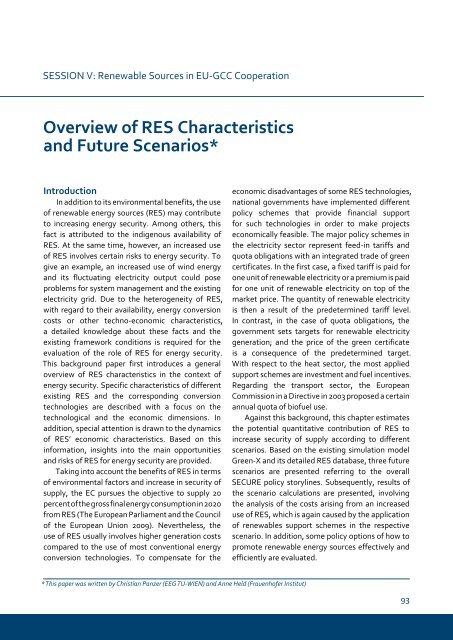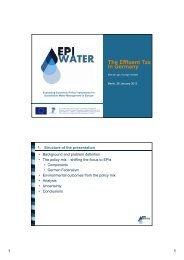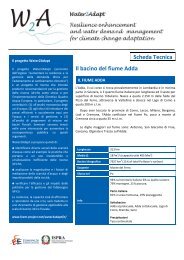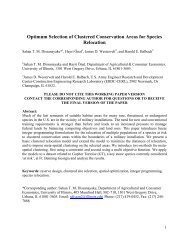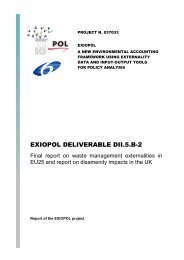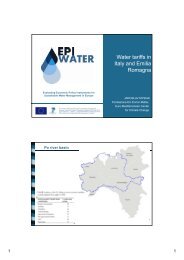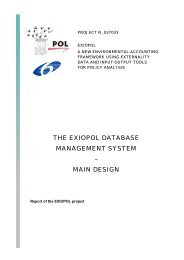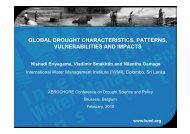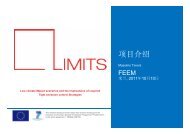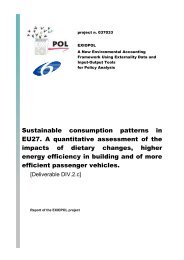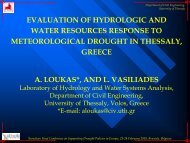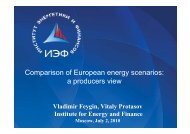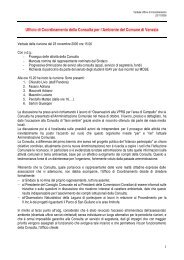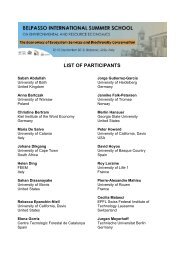Gulf and European Energy Supply Security - Feem-project.net
Gulf and European Energy Supply Security - Feem-project.net
Gulf and European Energy Supply Security - Feem-project.net
Create successful ePaper yourself
Turn your PDF publications into a flip-book with our unique Google optimized e-Paper software.
SESSION V: Renewable Sources in EU-GCC Cooperation<br />
overview of Res Characteristics<br />
<strong>and</strong> Future scenarios*<br />
Introduction<br />
In addition to its environmental benefits, the use<br />
of renewable energy sources (RES) may contribute<br />
to increasing energy security. Among others, this<br />
fact is attributed to the indigenous availability of<br />
RES. At the same time, however, an increased use<br />
of RES involves certain risks to energy security. To<br />
give an example, an increased use of wind energy<br />
<strong>and</strong> its fluctuating electricity output could pose<br />
problems for system management <strong>and</strong> the existing<br />
electricity grid. Due to the heterogeneity of RES,<br />
with regard to their availability, energy conversion<br />
costs or other techno-economic characteristics,<br />
a detailed knowledge about these facts <strong>and</strong> the<br />
existing framework conditions is required for the<br />
evaluation of the role of RES for energy security.<br />
This background paper first introduces a general<br />
overview of RES characteristics in the context of<br />
energy security. Specific characteristics of different<br />
existing RES <strong>and</strong> the corresponding conversion<br />
technologies are described with a focus on the<br />
technological <strong>and</strong> the economic dimensions. In<br />
addition, special attention is drawn to the dynamics<br />
of RES’ economic characteristics. Based on this<br />
information, insights into the main opportunities<br />
<strong>and</strong> risks of RES for energy security are provided.<br />
Taking into account the benefits of RES in terms<br />
of environmental factors <strong>and</strong> increase in security of<br />
supply, the EC pursues the objective to supply 20<br />
percent of the gross final energy consumption in 2020<br />
from RES (The <strong>European</strong> Parliament <strong>and</strong> the Council<br />
of the <strong>European</strong> Union 2009). Nevertheless, the<br />
use of RES usually involves higher generation costs<br />
compared to the use of most conventional energy<br />
conversion technologies. To compensate for the<br />
* This paper was written by Christian Panzer (EEG TU-WIEN) <strong>and</strong> Anne Held (Frauenhofer Institut)<br />
economic disadvantages of some RES technologies,<br />
national governments have implemented different<br />
policy schemes that provide financial support<br />
for such technologies in order to make <strong>project</strong>s<br />
economically feasible. The major policy schemes in<br />
the electricity sector represent feed-in tariffs <strong>and</strong><br />
quota obligations with an integrated trade of green<br />
certificates. In the first case, a fixed tariff is paid for<br />
one unit of renewable electricity or a premium is paid<br />
for one unit of renewable electricity on top of the<br />
market price. The quantity of renewable electricity<br />
is then a result of the predetermined tariff level.<br />
In contrast, in the case of quota obligations, the<br />
government sets targets for renewable electricity<br />
generation; <strong>and</strong> the price of the green certificate<br />
is a consequence of the predetermined target.<br />
With respect to the heat sector, the most applied<br />
support schemes are investment <strong>and</strong> fuel incentives.<br />
Regarding the transport sector, the <strong>European</strong><br />
Commission in a Directive in 2003 proposed a certain<br />
annual quota of biofuel use.<br />
Against this background, this chapter estimates<br />
the potential quantitative contribution of RES to<br />
increase security of supply according to different<br />
scenarios. Based on the existing simulation model<br />
Green-X <strong>and</strong> its detailed RES database, three future<br />
scenarios are presented referring to the overall<br />
SECURE policy storylines. Subsequently, results of<br />
the scenario calculations are presented, involving<br />
the analysis of the costs arising from an increased<br />
use of RES, which is again caused by the application<br />
of renewables support schemes in the respective<br />
scenario. In addition, some policy options of how to<br />
promote renewable energy sources effectively <strong>and</strong><br />
efficiently are evaluated.


